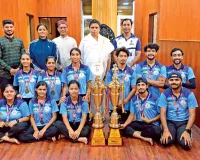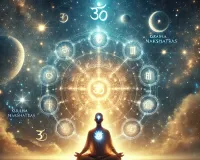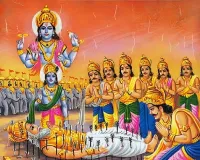Yog Science
On

Dr. Abhishek Kumar Bhardwaj Associate Professor,
Department of Psychology, Patanjali University, Haridwar
Prana means energy or life force and dimension means controlling energy. Prana nourishes and protects the mind and generates thoughts. Therefore, life is related to the mind. According to Maharishi Patanjali: Pranayam is to stop the movement of inhalation and exhalation. |
Yog is a way of life and it is useful for every person. There are many popular methods of yoga which describe techniques that pave the way for the holistic development of a person. Yoga includes physical exercises, breathing exercises, meditative techniques and philosophical principles. With regular practice of yoga, a person is able to recognize his inherent abilities and powers. Yoga brings out the hidden abilities in a person, which creates positive attitudes towards self and society and destroys negative energy. A person's personality develops in a healthy and balanced manner. There are many paths of yoga on which by walking, completeness of personality can be achieved. The method of each path is different but the purpose and goal of all is the same. Description of the scientific effect of some parts of yoga practice like asana and pranayama is given below -
Effect of Asanas
Asanas (physical exercises) have an impact on the physical and mental levels. Asanas affect every organ of the body, glands, muscles, nervous system and other systems and even cells. The blood vessels are affected by the contraction and expansion of body parts through asanas and blood flow in the body increases. regular practice of asanas due to this the muscles of the body become agile and flexible. Endocrine glands in the physical and mental development of a person endocrine glands play an important role. these glands effect of hormones released from physical and mental development itfalls on. Of these endocrine glands many asanas are considered important for proper development. The practice of asana also has an effect on the level of neurotransmitters does matter. A study conducted on yoga practitioners in a session of yoga effect of exercise (60 minutes) GABA (gamma amino butyric acid) was seen at neurotransmitter levels and 27 at GABA levels. The percentage increase was marked (Journal of Alternative and Complementary Medicine, 2007). in gaba level growth is related to lack of anxiety.
For the all-round development of children, they should be made to practice some asanas like Surya Namaskar etc. since childhood. The hormones released from endocrine glands found in the body are important in the physical and mental development of children. Practicing these regularly in the morning has a positive effect on children's memory and intelligence and also develops other cognitive abilities (reasoning power, problem solving, attention etc.).
Yoga is the scientific name of such a lifestyle which brings positive and qualitative changes in the entire life of a person. With this, a person not only gets free from diseases and ailments but can also attain Samadhi by its continuous practice. By continuous practice of Yoga, a person's weaknesses (symptoms of mental illness) like disease, grief, anxiety, stress, depression, self-deprivation, attachment etc. gradually disappear. Yoga is also helpful in increasing the working capacity and work efficiency of a person.
Benefits of Surya namaskar
• This is a complete exercise due to which every part of the body becomes healthy.
• It removes related deformities by making the spine and waist flexible.
• By practicing this, blood circulation improves in the entire body.
• Regular exercise helps in strengthening the stomach, small and large intestines, liver, kidney, lungs etc. are healthy.
• It has a positive effect on the endocrine glands respectively.
• Its regular practice increases alertness and provides good health.
Benefits of asanas
Practice of asana brings stability in the body and mind, provides relief from diseases and brings lightness in body parts (Hathayoga Pradipika, 1/17).
A brief description of the benefits of some main asanas is as follows -
• Padmasana: This is an excellent exercise to keep the body stable for a long time. As soon as the body becomes stable, the mind becomes calm, which intensifies the experience of meditation.
• Virasana: This asana balances the mind, increases concentration and provides relaxation at the psycho-physical level.
• Shashankasana: This exercise regulates the functions of the adrenal gland. The practice of Shashkasana provides mental peace by removing mental stress, anger, irritability etc.
• Mandukasana: Its regular practice is beneficial in obesity and stomach related disorders like constipation, acidity etc. Its practice is helpful in eliminating diabetes by activating the pancreas and balancing the amount of insulin.
• Simhasana: Its practice is especially beneficial in all throat related diseases like stuttering, tonsils, accumulation of phlegm in the alimentary canal etc.
• Kukkutasana: This exercise strengthens the muscles of the arms and shoulders as well as develops the sense of balance and stability.
• Bhujangasana: By practicing this, the spine becomes flexible and healthy, which strengthens the nerves and facilitates communication between the brain and the body. Bhujangasana is a panacea for people suffering from back pain and obesity.
• Makarasana: This is a beneficial exercise for slip disc, cervical spondylitis and sciatica.
• Marktasana: Practice of this asana is especially beneficial in back pain, slip disc, cervical spondylitis and sciatica pain.
• Shalabhasana: The entire automatic nervous system especially this exercise is helpful in stimulating the parasympathetic system. Shalabhasana is especially beneficial in back pain and sciatica pain. It cures all the diseases occurring in the lower part of the spine.
• Gomukhasana: This is a good exercise to achieve relaxation. Due to this, fatigue, stress and anxiety gradually reduce.
• Sarvangasana: By practicing this asana, proper amount of blood reaches the brain. It calms the mind, helps in removing emotional and mental stress, fear etc. Its practice also stimulates the thymus gland, as a result of which the capacity of the immune system increases (Asana, Pranayam, Mudra, Bandha; Swami Satyanand Saraswati).
• Halasana: Practice of Halasana improves the functions of the sympathetic nervous system and increases blood circulation in the entire body. Ardhahalasana makes our intestines strong and healthy and illuminates the digestive fire by removing constipation, obesity etc. ,
• Shirshasana: This practice increases blood flow in the brain which rejuvenates the entire body and mind. This practice is also helpful in removing anxiety and other psychological problems.
• Pawanmuktasana: This is a very good exercise for acidity, arthritis and abdominal gas disorders.
• Mayurasana: It harmonizes the endocrine glands, develops psycho-physical balance and increases muscular control. This practice results in balance between the tridoshas.
In this way, the practitioner gets many psycho-physical benefits by practicing the above asanas. Physical health is the basis of mental health, that is, it is necessary to be physically healthy for mental health.
Effect of Pranayama
Through Pranayama, a person becomes physically, mentally and spiritually healthy and strong. Through Pranayam, blockage of nerves is removed and it makes the vital body powerful and strong. This develops the ability of concentration in a person, hence breathing exercises especially Bhramari Pranayam are recommended for students is considered extremely beneficial.
Mental Health and Pranayama:
Research based evidence
Prana means energy or life force and dimension means controlling energy. Prana nourishes and protects the mind and generates thoughts. Hence prana is related to mind. According to Maharishi Patanjali: Speed of breathing stopping the is pranayama.
Tamin Sasi Shwasprashvasyogartivichchhedah Pranayamah
112/49, Yoga Darshan..
The entry of vital air into the body is inhalation and its exit is exhalation. Stopping of the movement of these two i.e. stopping of the process of movement of vital air is the common symptom of Pranayam. Here, Pranayama is said to be completed after completion of Asana. While practicing Pranayama, stability of the asana is very important. The practice of pranayama has a stimulating effect on neurotransmitters. The process of Pranayama activates the hypothalamus. During the practice of pranayama, the amount of norepinephrine decreases and the amount of dopamine in the blood increases. Dopamine is a neurotransmitter secreted from the brain which is responsible for happiness and joy.
Similarly, different types of breathing exercises also have an effect on other important functions of the body like heartbeat, operation of lungs, secretion of juices in digestive organs. These actions are not under our voluntary control. The autonomic nervous system is divided into two parts – sympathetic nervous system and parasympathetic nervous system. These systems work opposite to each other and also complement each other. The work of making the body functional is done by the sympathetic nervous system. When the body needs strength by postponing its normal activities to face an adverse situation, it obtains strength through this mechanism. On the contrary, the parasympathetic system saves physical energy by reducing the activity of various parts of the body.
Although both systems work opposite to each other, they continue to influence each other. Generally their balance is maintained, but when imbalance occurs due to changing circumstances, the person's behavior also changes accordingly. When the sympathetic system becomes particularly active, the respiratory rate, pulse rate, blood pressure, heart rate etc. increase and On the contrary, stimulation of the parasympathetic system changes a person's behavior laxity sets in.
The task of controlling the mind is possible only through Pranayam. The mind turns towards worldly things when it sees attraction in them. But when the soul element and the ability to self-analyze develop through Pranayama, the mind does not get attracted towards that. Maharishi Patanjali has explained the benefits of Pranayam through these sources-
Tat Kshiyate Prakashavaranam 112/52, Yoga Darshan.
That is, the practice of pranayama weakens the covering of light (knowledge).
Dharanashu Cha Yogyata Manasah 112/53, Yog Darshan.
That is, the practice of pranayama also gives the mind the ability to hold.
Pranik energy is the basis of our life force and immunity. There is a close relationship between life and mind. Along with controlling the breath, there is also control over the mind. It is said in the scriptures of Yoga that by continuous practice of Pranayam, the waves of the mind become calm. The movement of the mind stops. Nadi Shodhan Pranayam helps in cleaning the nadis so that mental activities become possible smoothly. It calms the mind and brings gentleness in behaviour. Pranayama gives direction to the irregular flow of thoughts. When breathing is deep the mind also becomes calm.
Prana means air (life force) circulating in the body and dimension means regulation (control). Its regular practice provides overall health.
• Nadi-Shodhan Pranayama: This breathing exercise nourishes the entire body due to availability of more amount of oxygen. The respective centers of the brain get excited and start working at their maximum capacity. This provides mental peace, concentration and clarity in thoughts. This practice brings harmony to the life force and increases life force and reduces stress and anxiety (Asana, Pranayam, Mudra, Bandha; Swami Satyanand Saraswati).
• Anulom-Vilom Pranayam: This purifies all the nerves in the body. With continuous practice for ten days, an increase of 86 percent was recorded in the spatial memory (ability to identify paths, shapes, etc.) scores (Psychological Reports, 1997). In one study it 20 minutes of practice was shown to increase selective concentration (Perceptual and Motor Skills, 2007). This practice helps in treating ADHD. It is effective in managing attention deficit hyperactivity disorder (ADHD) and increasing concentration and memory capacity.
• Shitali Pranayam: This practice provides coolness to the body and mind. Affects important brain centers related to libido and temperature regulation. It is also helpful in calming mental and emotional excitements (Asanas, Pranayama, Mudras, Bandhas; Swami Satyananda Saraswati).
• Bhramari Pranayam: Its regular practice is helpful in removing anger, insomnia and other mental problems. By practicing Bhramari Pranayama, it is possible to manage anxiety disorders and nervousness etc. This practice is very beneficial in mental diseases. It provides health and peace by removing migraine, mental excitement and restlessness of mind. This is a very useful exercise for meditation.
• Ujjayi Pranayama: This practice is useful in calming the nervous system and mind. Ujjayi Pranayama is an effective practice in diseases like thyroid, snoring during sleep, throat related disorders, fever etc. It makes the voice sweet. Therefore its practice is especially useful for singers. Stammering and lisping in children can also be cured by this.
• Bhastrika Pranayama: It balances and strengthens the nervous system helps in attaining mental peace and concentration to prepare for meditation. With the practice of Bhastrika Pranayama, reaction time gradually decreases (Indian Journal of Physiology and Pharmacology, 2003).
• Suryabheda Pranayama: This practice is in extroversion and mobility increases efficiency in performing physical activities and removes depression. to people with retarded intelligence or those who are outsiders difficulty in interacting with or adjusting to the environment experience, they are advised to practice is (Asana, Pranayama, Mudra, Bandha; Swami Satyananda Saraswati).
Do the above yoga exercises carefully, as per your capacity and skillfully it is beneficial to do yoga under the guidance of an instructor. to the practitioner correct procedure of related asanas, pranayama or other exercises (as described in yoga texts or specified by a yoga guru), his knowledge of scientific benefits etc. is also necessary. related exercises under what circumstances is it prohibited or in case of any abnormal psycho-physical which exercise should not be done in this condition, all these things information a yoga practitioner should have.
लेखक
Related Posts
Latest News
01 Oct 2024 17:59:47
ओ३म 1. सनातन की शक्ति - वेद धर्म, ऋषिधर्म, योग धर्म या यूं कहें कि सनातन धर्म के शाश्वत, वैज्ञानिक,...


















.jpg)
.jpg)
